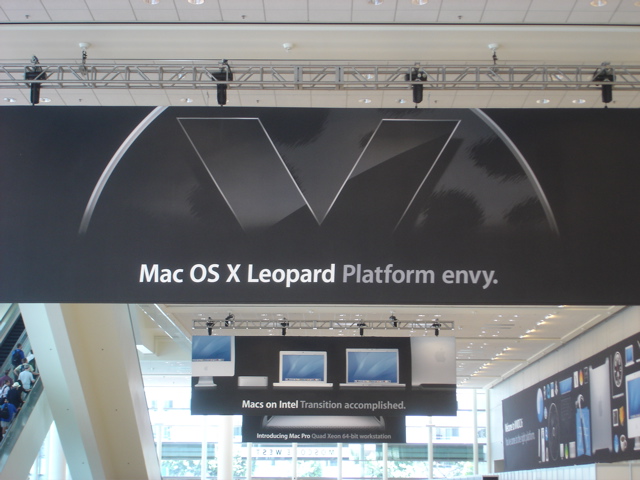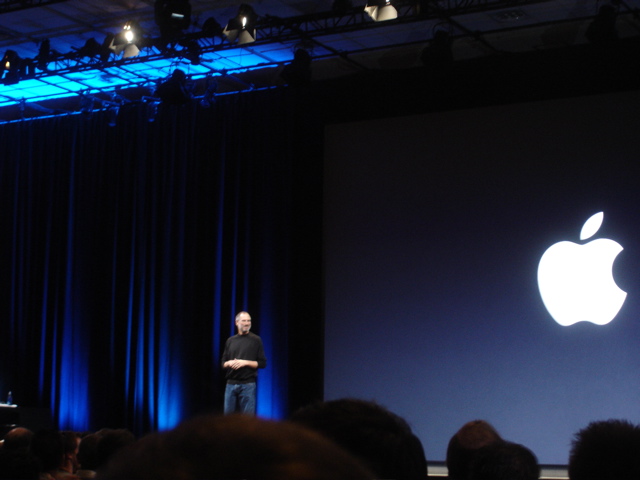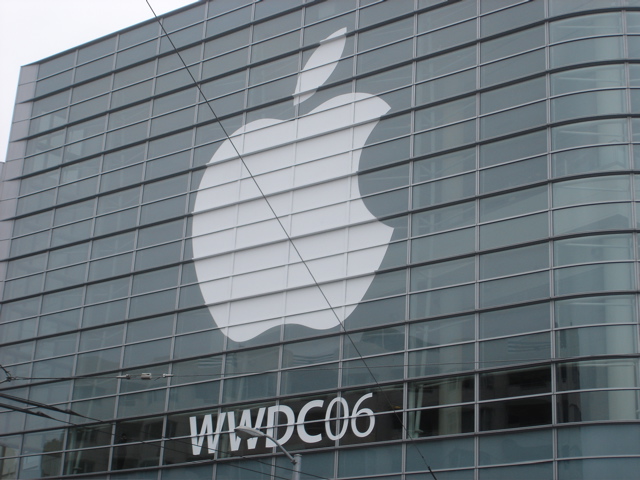Apple Inc.: August 2006 Archives
Last night, I got side-tracked from my normal web surfing and blogging habits, when I came across the infamous Steve Jobs keynote at MacWorld Boston in 1997. This speech was apparently delivered at a time when Apple's outlook was at its lowest ebb, and just weeks after Steve returned to Apple. What is amazing about this speech is how Steve Jobs lays out how he is going to turn around Apple, in very simple terms. And then, over the course of the next 9 years, he and his team at Apple did everything that he said that they were going to do (and more), and now Apple is positively resurgent.
There are a couple of amazing things about this speech. The first is the amount of vision displayed by Steve Jobs. Apple isn't the only computer company to be faced with the challenge of changing market dynamics that threatened their relevance. The computing industry is littered with the husks of failed companies that went to the market with the wrong strategy. SGI, for example, had the same sort of crisis that Apple did. They decided to go from selling MIPS-based workstations running their own proprietary from of UNIX (called IRIX) to selling Intel-based workstations running Windows NT. While the analysts of the time applauded the move, it was clearly the wrong strategy - as now SGI is a shadow of its former self.
Steve Jobs, on the other hand, correctly determined that one of Apple's core assets was its proprietary operating system, MacOS. During the speech, he stated that Apple was going to invest tremendously in the MacOS, a move which seemed to defy "conventional" wisdom[1]. Yet, once again, what separates Steve Jobs from a lot of other CEOs is that he posses a combination of technological and business understanding. Thus, he made the right decision.
A decision, by the way, which stands to this day. I was really impressed with the amount of work that I saw going into Mac OS X at WWDC. Apple is continuing to make Mac OS X better by leaps and bounds. Most of the "good stuff" that we have seen so far in Leopard are things that are more "behind the scenes" - new APIs and hooks for developers writing third party applications. Things that make the platform richer for developers, and therefore for their end users.
The other amazing thing about the speech is that it is one of the few times that I have seen Steve Jobs get flat-out booed by the Apple faithful. It happened a few times, most impressively when he announced Apple's partnership with Microsoft ("the enemy"). This shows another important characteristic of what has made Steve Jobs so instrumental in Apple's revival -- he's not afraid to step on people's toes. In this case, he knew that the right course for Apple was to work together with Microsoft. But he also knew, that the Apple faithful (who had really been supporting Apple during the "dark days") weren't going to like it. Yet, her persevered, and the rest is history.
Interestingly, Microsoft must have really made out on that deal. The $150 million that they invested was in Apple in the form of stock, which they had to hold for three years. In August of 1997, Apple's stock was worth around $18 per share. Three years later, the stock was at nearly $50 per share, after a 2-for-1 split! So, if Microsoft sold the stock in 2000, it means that they made over $450 million of pure profit. And they continued selling Office for the Mac at a profit. And lastly, they have been essentially using Apple as outside R&D - as the latest version of Windows, Vista, appears to be heavily influenced by Mac OS X.
So, while the popular theory is that convincing Microsoft to invest in Apple was a coup for Steve Jobs, I think it was really a coup for both companies. It continually amazes me, when I think about this, how what's important for a company isn't simply vision, but what matters is having the right vision. I think that far too often, this sort of vision is lacking at most major companies (and possibly also governments). That is what makes following Apple so interesting. And it is also why if you are in business school, you positively owe it to yourself to study this case example. It's amazing.
-Andy.
- The Wired article that I referenced, "101 Ways to Save Apple", is also fairly interesting in its own right. It is amazing how many of the 101 things are flat-out wrong, and that the Apple-under-Steve-Jobs thankfully ignored. This article is one of my classic examples of how the pundits and analysts are almost always wrong. ↩
Technorati Tags: Apple, Macintosh, Steve Jobs, WWDC, MacWorld, SGI
Over in the IT lab, they have one of the new Intel-based XServes on display. I managed to snap a few photos, including one of the back of the server. It seems like there is now a graphics controller integrated with the motherboard, as evidenced by the mini-DVI port on the back:
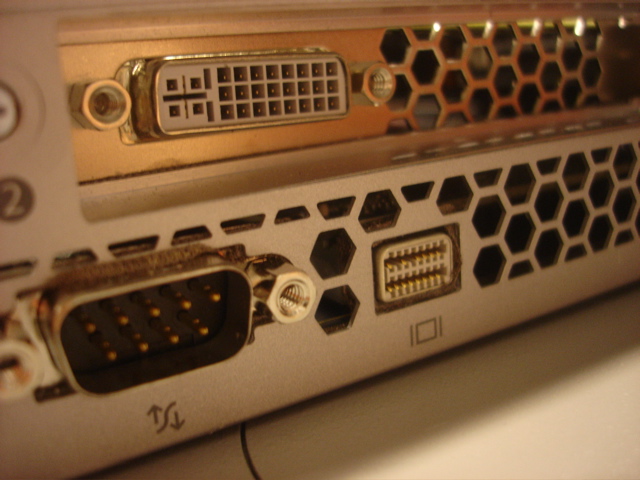
Even though this machine had a PCI-E graphics card installed, you don't need to do this if you just want something simple for administering the machine.
-Andy.
A combination of little sleep and getting "blasted with the information firehose" means that I am extremely tired right now. Tired, but satisfied. Will and I managed to get pretty close to the stage for the keynote - we were slightly right of center, and less than 15 rows away. And while the format of this year's keynote was a little odd (lots of speakers divvied up the work), I am pleased with what Apple announced. With the new Mac Pro, Apple has not only fixed a number of classic gripes with the old G5-based Power Mac, but they also appear to be providing some decent value to boot. While the comparison with Dell that Phil Schiller made in the keynote wasn't totally above board (the Dell was configured with a super-expensive graphics card -- shame on you Apple), it seems like Apple's new Mac Pro is going to be cheaper than a similarly priced Dell. And that is pretty amazing, when you think about it.
I am running the Leopard Developer Preview on my PowerBook right now, and at this stage, the amount of change over Tiger is fairly subtle. As Steve Jobs said in the keynote - Apple is doing things a bit differently this year, and keeping some of the upcoming features of Leopard close to their chest. So, I suspect that when we do finally get the final build of Leopard, things are going to be quite a bit different than the Developer Preview.
-Andy.
After lunch yesterday, Will and I wandered into S.F. to find the hotel suite where VMWare was demonstrating their upcoming Mac OS X release:
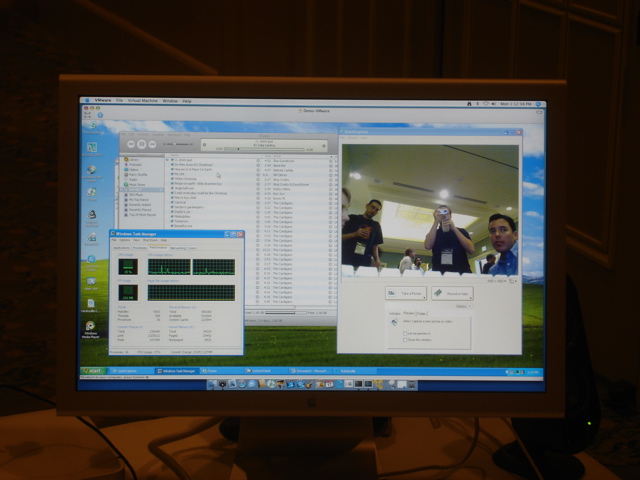
In the above photo, you can see VMWare running Windows XP inside of a VM running on a Mac mini. The VMWare demo that we saw appeared to have pretty amazing USB support - in the screenshot you can see iTunes connected to an attached iPod, and a logitec USB camera displaying a live video feed. In addition, the VMWare VM can expose the two cores of a Core Duo chip into the virutalized operating system - so Windows XP actually saw two processors.
It didn't look like much has been done in the way of UI work -- they weren't able to show me any UIs for configuring VMs or building new ones. The VMWare representatives did say that they were going to do everything in Cocoa, fortunately.
All-in-all, an impressive demo, but the jury is still out in terms of when this is going to come out (not until 2007, it seems), and how much its going to cost (currently, VMWare workstation goes for $200).
-Andy.
Apple has these signs posted all around the conference hall:
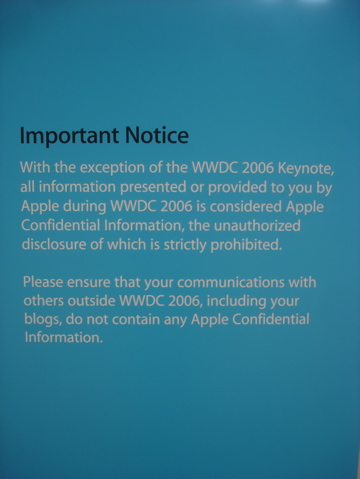
Of course, while I see Apple's point, and I'm going to do my best to respect their wishes, I think that this policy is extremely stupid. Apple needs to get the word out about their platform, and how great it is. And any little thing that can be done to help -- posting information on blogs, discussion forums, mailing lists, etc. can only help Apple in their quest to keep the Mac OS X platform relevant.
-Andy.
I was going to blog about this awhile ago, but I'm going to be at Apple's Worldwide Developers Conference (WWDC) in San Francisco all this week. I have been wanting to go forever, so this year I finally decided to send myself, rather than waiting until I was employed somewhere more Mac-friendly. I'm hoping for a lot of cool announcements today, and to learn a lot about how to code for the Mac.
-Andy.
